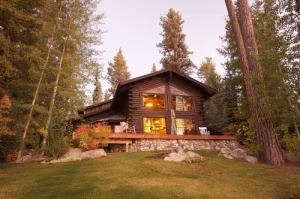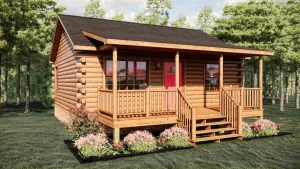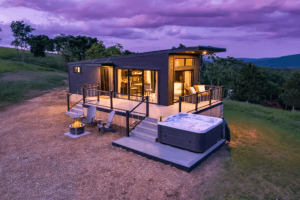Reclaimed wood is making waves in the world of log cabin construction, and for good reason. As homeowners become more eco-conscious, this sustainable material has emerged as a favorite choice among builders and buyers alike. Imagine crafting your dream retreat from timber that tells a story—each knot and grain offering a glimpse into its past life. The charm of reclaimed wood not only enhances the beauty of log cabins but also contributes to a growing trend towards environmentally friendly building practices. Whether you’re constructing a cozy weekend getaway or an expansive family home, incorporating reclaimed wood can elevate your project while being kind to Mother Earth. Let’s dive deeper into why this resourceful material is capturing hearts—and homes—everywhere!
The environmental impact of using reclaimed wood
Using reclaimed wood significantly reduces the demand for new timber. This helps to conserve our forests, which are vital ecosystems that absorb carbon dioxide and support biodiversity.
The process of harvesting new lumber often involves heavy machinery, leading to soil erosion and habitat destruction. By opting for reclaimed material, we minimize this impact while giving old wood a second life.
Reclaimed wood also requires less energy to process since it’s already been dried and treated. This results in lower greenhouse gas emissions compared to traditional logging practices.
Additionally, using these materials keeps them out of landfills where they would otherwise contribute to waste problems. Each piece carries its own story and history, making every cabin unique not just in appearance but also in the journey behind its creation.
The durability and strength of reclaimed wood compared to new wood
Reclaimed wood often boasts exceptional durability. This is due to its age and the natural processes it has undergone over time. As trees grow old, their fibers become denser, making them stronger.
In many cases, reclaimed wood comes from structures that have weathered years of exposure to the elements. This kind of resilience speaks volumes about its ability to withstand similar conditions in a new log cabin setting.
New wood might seem appealing for its novelty, but it lacks the character and history embedded in reclaimed materials. Each piece tells a story while providing robust structural integrity.
Moreover, reclaimed wood can be less susceptible to warping or splitting compared to newly harvested lumber. Its seasoned nature gives builders confidence in its longevity as they design eco-friendly cabins that are meant to last generations.
Cost-saving benefits of using reclaimed wood in log cabin construction
Using reclaimed wood in log cabin construction can lead to significant cost savings. Often, this material is more affordable than new lumber. With an increasing demand for sustainable resources, prices of fresh timber can fluctuate wildly.
Reclaimed wood offers unique characteristics and reduces the need for extensive processing. This means less energy spent during production translates into lower costs overall. Plus, many suppliers offer reclaimed materials at competitive rates due to their surplus.
Additionally, building with reclaimed wood can minimize waste disposal fees associated with traditional demolition projects. Salvaging material not only cuts down on expenses but also aligns perfectly with eco-conscious values.
Investing in reclaimed wood often leads to reduced labor costs as well. Contractors familiar with handling such materials may work faster and more efficiently than when dealing with conventional timber sourced from remote locations.
Unique aesthetic appeal of reclaimed wood in log cabins
Reclaimed wood offers a distinctive charm that new lumber simply can’t replicate. Each piece tells its own story, often showcasing history through unique knots, grain patterns, and color variations.
The weathered look of reclaimed wood adds character to log cabins. It evokes a sense of warmth and nostalgia that is hard to match with contemporary materials.
Using reclaimed wood creates an organic feel in the space, seamlessly blending with nature. Its rustic aesthetic enhances both interior and exterior designs.
Additionally, when combined with modern elements or traditional features, it can create striking contrasts that elevate the overall design. Homeowners often find this blend allows for personal expression while maintaining harmony with the surrounding environment.
Choosing reclaimed wood not only provides beauty but also fosters an inviting atmosphere where memories are made and cherished.
Tips for sourcing and selecting the right reclaimed wood for a log cabin project
When sourcing reclaimed wood for your log cabin, start by researching local suppliers. Look for companies that specialize in salvaged materials; they often have a rich inventory to choose from.
Next, consider the type of wood you need. Different species offer varying aesthetics and durability. Oak provides strength, while pine delivers a rustic charm.
Inspect the wood carefully before purchasing. Check for signs of damage or pests—look closely at knots, cracks, and discoloration.
Ask about the history of each piece; knowing where it came from can add character to your cabin story.
Don’t hesitate to negotiate prices or ask about bulk discounts if you’re buying large quantities.
Trust your instincts when selecting pieces that resonate with your vision—they will become part of your home’s identity.
Case studies and success stories of log cabins built with reclaimed wood
One remarkable case is the Timberline Lodge in Oregon. Built entirely from reclaimed wood, it showcases the beauty of aged timber while boasting sustainable practices. The lodge has become a popular destination for eco-conscious travelers who appreciate its rustic charm.
Another inspiring story comes from a couple in Colorado who transformed an old barn into their dream log cabin. By using beams and planks salvaged from the barn, they created a unique home filled with character and history. Their project highlights how reclaimed wood can tell a story that new materials simply can’t replicate.
In Vermont, a community center was constructed using locally sourced reclaimed wood, emphasizing environmental responsibility while fostering local craftsmanship. This space has become an integral part of the community, illustrating how sustainability can enhance both functionality and aesthetic appeal in architecture.
These examples demonstrate the diverse applications and benefits of reclaimed wood in log cabin construction.
Conclusion: Why choosing
Choosing reclaimed wood for log cabin construction is a decision that resonates beyond aesthetics. It reflects a commitment to sustainability and environmental stewardship. By opting for materials that have history, you contribute positively to the planet.
The character of reclaimed wood adds warmth and charm to any cabin. Each piece tells its own story, creating a unique ambiance that new wood simply cannot replicate.
Additionally, using reclaimed materials can lead to significant savings. With careful sourcing, builders can find high-quality wood at lower costs compared to brand-new lumber.
Moreover, the durability of this timber often surpasses that of fresh-cut alternatives. As it ages naturally through exposure, it becomes more resilient over time.
Choosing reclaimed wood enriches your log cabin experience on multiple levels—from ecological impact to personal satisfaction in craftsmanship.
FAQS
What is reclaimed wood?
Reclaimed wood refers to timber that has been salvaged from old buildings, furniture, or other structures. It’s recycled material with a rich history and character.
Is reclaimed wood more expensive than new lumber?
Prices can vary widely. While some reclaimed wood can be pricey due to its unique qualities, it often proves cost-effective when considering long-term durability and aesthetic appeal.
How do I know if the reclaimed wood is safe to use?
Always check for signs of treatment chemicals or decay. A reputable supplier should provide information on the source of the wood and any necessary testing done for safety.
Can I use reclaimed wood for structural elements in my cabin?
Yes, many builders successfully use it for beams and framing. However, ensure it’s assessed by a professional prior to installation to guarantee its integrity.
Where can I find quality reclaimed wood?
Look at local salvage yards, auctions, or specialty suppliers who focus on sustainable materials. Networking within eco-conscious communities may also yield hidden gems.
Refferences
Choosing reclaimed wood for log cabin construction not only enhances the overall aesthetic but also contributes positively to the environment. The durability, strength, and unique character of reclaimed wood make it an excellent choice for builders looking to combine sustainability with style.
Whether you aim to create a rustic retreat or a modern mountain home, sourcing high-quality reclaimed wood can lead to stunning results that tell a story of their own. With its cost-saving benefits and ecological advantages, reclaiming timber is proving to be more than just a trend; it’s becoming a staple in thoughtful building practices.
References:
1. “The Environmental Benefits of Reclaimed Wood.” Sustainable Lumber Company.
2. Smith, J., & Perez, L. (2022). Building Green: A Guide to Sustainable Log Cabin Construction.
3. “Reclaimed Wood: The Durable Alternative.” Timber Industry Association.
4. Johnson, R., & Thompson, K. (2020). Rustic Elegance: Designing Homes with Reclaimed Materials.
5. EcoBuilding Pulse Magazine – “How Reclaimed Wood Can Shape Your Next Project.”
6. “Case Studies on Log Cabins Built from Reclaimed Timber.” Journal of Architectural Sustainability.




